This will be the third, and final, installment of Pictorial Essays on (only) American Automobiles. With a couple exceptions at the very end, this article does not cover current concept cars … cars that fly, cars that go underwater, cars shaped like a wheel, cars that get 500 miles per gallon on a cup of peanut oil, cars that go 400mph, etc. etc., … it is about concept cars of the past.
The focus here will be the pictures of the cars. I will attempt to keep the narratives on each car to a bare minimum, so as to not detract from the extreme coolness of the car itself. But, links pointing you to more information for most vehicles will be provided. The list is ordered by year.
NOTE: Three cars appear here that also appeared in my “Rare and Beautiful” article. I only show the pictures in this post. To read about them, click on this link; http://www.theburningplatform.com/2014/12/21/pictorial-essay-26-very-rare-and-stunning-american-cars/
========================================================
1934 FORD MODEL 40 SPECIAL SPEEDSTER

Edsel B. Ford was involved with this design …. yeah, that Edsel. Some say it’s a 1932 model because it was built atop a 1932 Ford chassis. Edsel conceived this idea after he returned from a trip to Europe in 1932. He then asked car designer Bob Gregorie to design and supervise the construction of a “sports car” like those he’d seen in Europe. Only five similar vehicles were built because the price, $2,500, was a lot of money back them. One sold last year at auction for $1,760,000.
1938 BUICK Y JOB

The first ever concept car built by GM …by Henry Earl. (Hey, at least they didn’t call it a B Job). Futuristic styling, highlighted by bold curves, it attempted to mimic elements seen in Chrysler’s Airflow design, it featured concealed headlamps, power windows and other electric options, and a convertible roof that folded under a metal cover when closed. The Y Job exerted its influence for more than a decade, serving as the model for Buicks until the 1950s … and set the gold standard for what a concept car could accomplish.
http://www.prewarbuick.com/features/why_the_y_job
1938 STOUT SCARAB

The first minivan. This car is discussed in my “Rare and Beautiful” article
http://blog.hemmings.com/index.php/tag/stout-scarab/
1938 PHANTOM CORSAIR

The brainchild of Rust Heinz – son of the Ketchup King. The Phantom Corsair was based on a 1936 Cord Westchester Sedan with a Granatelli modified 192 horsepower supercharged Cord motor. Covered in my “Rare and Beautiful” article.
1941 CHRYSLER THUNDERBOLT

This car was named as a tribute to George Eyston’s 1938 Thunderbolt which reached 357 mph on the Bonneville Salt Flats. Both cars shared the same fender-less, slab-sided shape with wheel shirts. One of few cars ever built without a front grill. Chrysler billed this as “the car of the future.” Built during the popular Art Deco deco movement with clean, gentle lines …. before every car (seemingly) was designed to look like a jet fighter. Designed by Alex Tremulis ….. the legendary designer of the Tucker. The car had a host of electric features; electro-hydraulic doors, electric windows and electric pop-up headlights. Very plush interior with leather upholstery and a bespoke aluminum dashboard.
http://www.imperialclub.com/~imperialclub/Yr/1941/thunderbolt/index.htm
1947 TIMBS


Appeared in the October 1949 issue of Motor Trend. It was called a ”Home-Made Streamliner” …. because supposedly the car could be made on any workbench, by any builder. It took Norman Timbs 2 ½ years and $10,000 to build. Most of the car consists of Buick parts. It’s just four feet from the ground to the windshield, 18 feet long, a wheelbase of 117 inches, and a top speed of 120mph. With the touch of a button the entire rear of the vehicle lifts hydraulically to expose the engine, fuel tank, and spare tire.
1948 TASCO
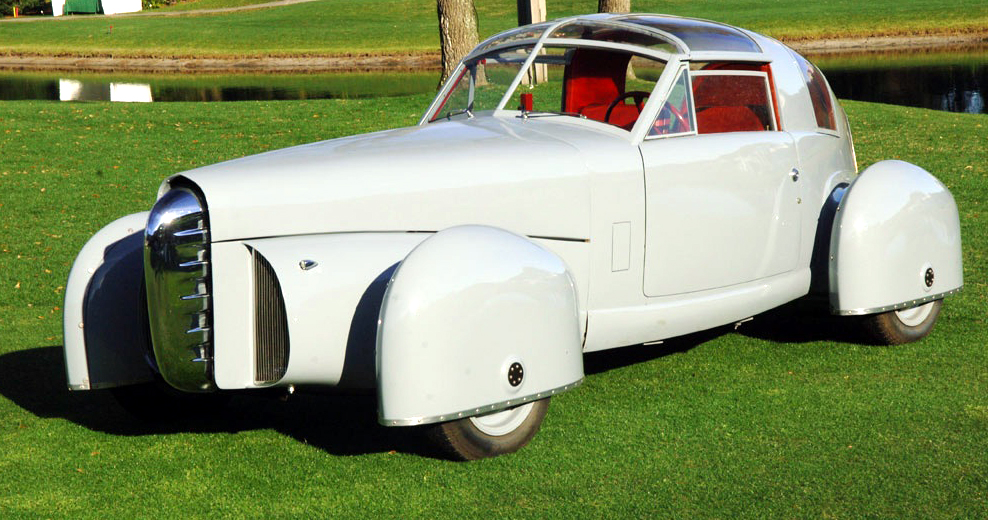
What the heck … might as well include an ugly car. The beginning of car designs modeled after airplanes. ‘Tasco’ is an abbreviation for ‘The American Sports Car Company.’ It is the first car in the world with a T-top roof. The designer, Gordon Buehrig, sued GM when they used it on the 1968 Corvette. He got bupkus. It is currently on display in the Auburn Cord Duesenberg Museum in Auburn, Indiana.
http://news.boldride.com/2013/12/the-1948-tasco-prototype-is-part-plane-part-car/11639/ (lots of pics)
1950 GENERAL MOTORS FUTURLINER BUS
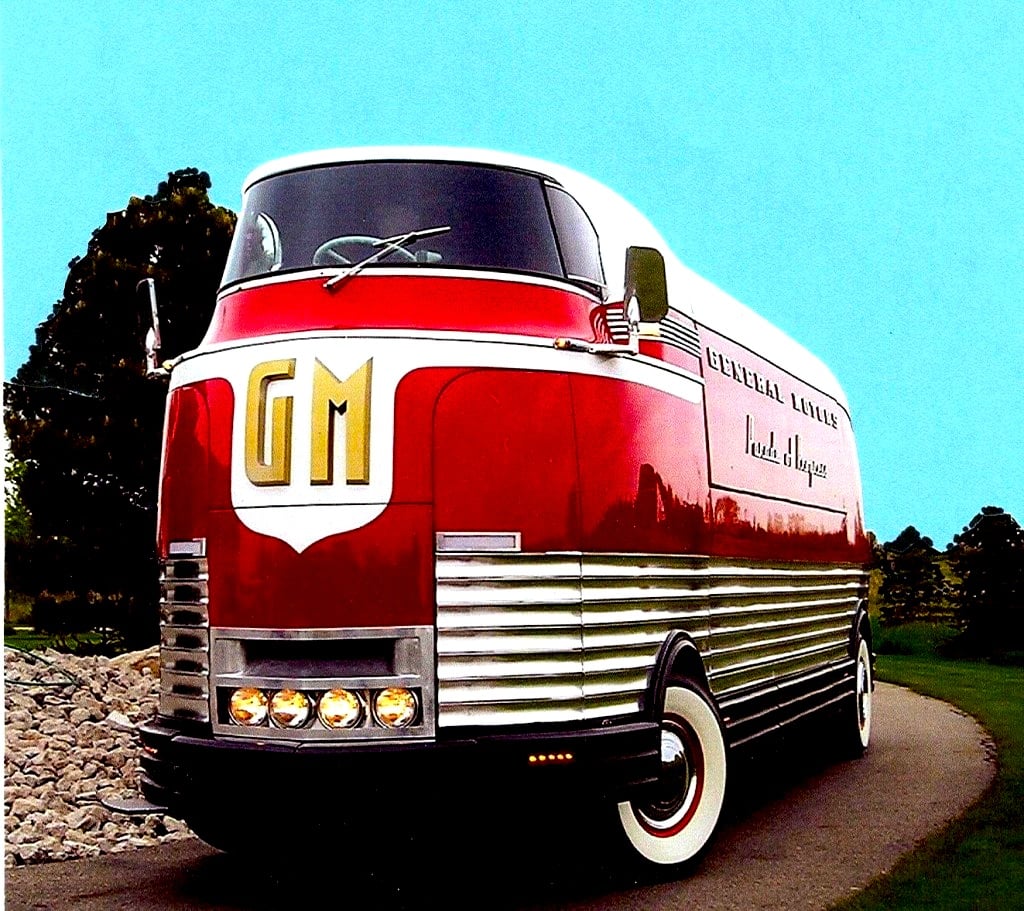
GM built 12 0f these buses (9 still exist) for their Parade of Progress — a traveling exhibition promoting future cars and technologies. (One sold recently for $4.5 million). Specs; 33 feet long, 8 feet wide, 11+ feet tall, and weighing 12+ tons Gorgeously styled Art deco bodywork; deep red side and white roof paint, large articulated chrome side panels, a military-grade 302-cu.in. GMC straight-six gasoline engine and automatic transmission, whitewall tires and a prominent, high-mounted, centrally located driver command position with a panoramic windshield. Simply gorgeous.
//en.wikipedia.org/wiki/GM_Futurliner
1951 GM LeSABRE

First, it was not a Buick, although Buick picked up the LeSabre name in 1959. The name came from the Air Force Sabre jet fighters, so the car’s front jet-like intake held two headlights, the rear fins hinted at P-38 inspired Cadillac fins, and the rear nozzle also was jet inspired. The instruments said aircraft in style and included an altimeter. Fuel tanks for gasoline and methanol were in the rear fenders, which limited trunk space.
Regarded by many car enthusiasts as one of THE most important concept cars of its age. It literally changed automotive building forever. It was a rolling test laboratory for radical new types of materials. 12-volt electrics (most cars then were 6-volts), a torque converter automatic transmission with an oil cooler, fuel injection, a strong, chrome-molydenum frame, built-in hydraulic jacks, a rain-activated folding top, a jet-like air intake and prominent tail fins. But it was the landmark aluminum engine that set this car apart …. it displaced just 217 cubic inches, but produced 335hp.
http://auto.howstuffworks.com/1951-general-motors-lesabre.htm
1952 EX-122
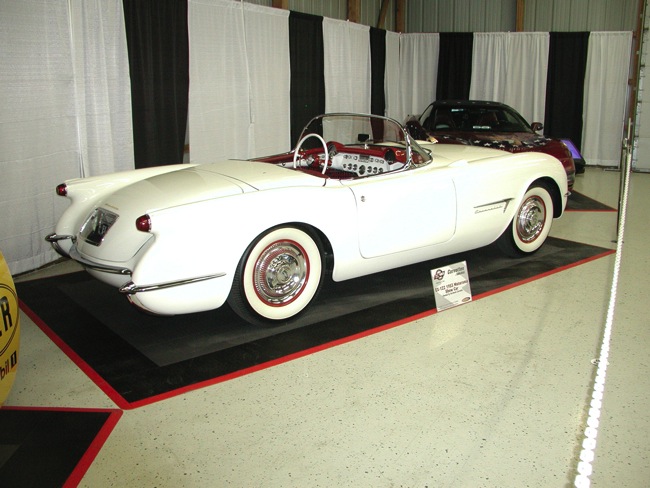
You’re looking at the world’s oldest Corvette. In 1951, work began on the EX-122 concept car. In 1952 GM changed the name to Corvette. And Americans would get their first peek at this beautiful Corvette on January 10, 1953 at GM’s Motorama in New York City.
1954 GM FIREBIRD(S)


GM built a series of Firebirds (NOT the same as the Pontiac version) that looked like a jet plane on wheels. These cars were never intended for production. GM’s goal was to determine the feasibility of gas turbine engines.
The 1954 Firebird was a one-person vehicle and sported a 370hp Whirlfire Turbo Power gas turbine engine. The 1956 Firebird II seated four people featured with an improved gas turbine (its exhaust temperature was only 225 degrees Fahrenheit vs. the Firebird I’s blistering 1,250 degrees) and held 4 people. It was also the first car to feature disc brakes and fully independent four-wheel suspension. The 1958 Firebird III (above), was the most streamlined of all, with a wide tapered nose and separate bubble canopies for driver and passenger. It also featured a single-stick control handle, like jet fighters. Top speed on all of them is estimated at around 200mph.
http://myautoworld.com/gm/history/gm-firebird-53-59/gm-firebird-53-59.html
1955 CADILLAC LaSALLE ROADSTER II

Betchya never saw a Caddy like this before! A toy that would probably fit in the trunk of a regular Caddy. Introduced in the 1955 Motorama Show, this concept went …….. nowhere.
1955 CHEVROLET BISCAYNE XP-37
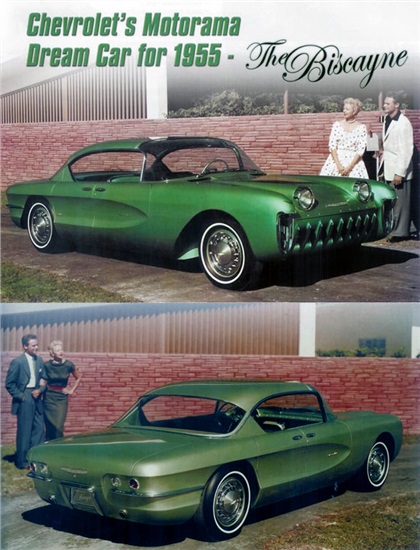
Not every concept car was built with the distant future in mind. Sometimes the manufacturer just wanted to showcase ideas that were just around the corner. The Biscayne XP-37 served this purpose for GM. Just from the picture you can see some Corvette design ideas. The body is a special shell of glass-fiber-reinforced plastic. The windshield sweeps over the driver’s head to form part of the roof. The new four door design requires no center pillars. And the engine was an experimental high compression Chevrolet V8 (215hp) with dual exhaust, four barrel carburetor and high lift cam …. elements of which would later play into Corvettes, Rivieras, Corvairs, and Eldorados.
http://www.carstyling.ru/ru/car/1955_chevrolet_biscayne/
1955 CHRYSLER/GHIA GILDA

Commissioned by Chrysler in 1955 and designed Italian coachbuilder Ghia. Named after Rita Hayworth’s voluptuous vamp in the movie Gilda. Designed and shaped to take a gas-turbine, but instead fitted with a 1.5-liter OSCA four-pot.
http://www.motortrend.com/classic/features/12q3_1955_ghia_gilda/
1955 LINCOLN FUTURA

If this concept car looks familiar, it should, because it’s the original …………….. Batmobile.
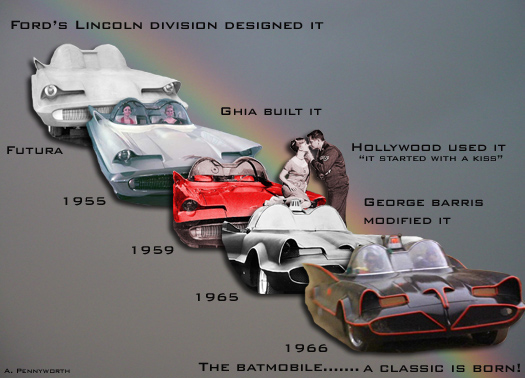
Bill Schmidt, Ford’s lead stylist, said the design inspiration came from his scuba diving encounters with sharks … hence, the predatory full width grille, ominously hooded headlights, killer tail fins, all stretched over a low, long, and wide body. Lincoln stuffed as many Jetson’s type gadgetry they could into its 19 foot length. Ford eventually sold the car to an employee, George Barris, for one dollar.
In 1965, with three weeks to go until the Batman show would be released, ABC still did not have a vehicle. They contacted George Barris. He retained the chassis and the basic shape of the car ….. while overhauling the nose and tail …. a bat-nose, a bat-tail, a bat-muffler, a bat hood ornament, bat-wheels, and all kinds of other bat memorabilia designed to make Batman say, “Holy Batcrap, Robin!”
http://www.thehistoryblog.com/archives/21816
1956 BUICK CENTURION

Stunning four-passenger coupe with a fiberglass body and an all-glass top. Had a television camera mounted in the trunk, and a receiver on the instrument panel displayed images from the camera (in 1956!!!) The gear shifting mechanism is a knob in the center of steering wheel, and the radio dial is on a tube that protrudes from the dashboard between the two front seats. The doors don’t have any handles, and are opened by buttons instead. A 325-hp V-8 engine provided thrust.
http://www.carstyling.ru/en/car/1956_buick_centurion/
1958 FORD NUCLEON

Hey … how about a NUKE powered car!! What could go wrong? The rear section of the Nucleon was made up of twin booms, which were intended to carry a nuclear reactor and shielding. Ford left it up to top scientists to determine whether the reactor, or power capsule, ran off nuclear fission or fusion. The power capsule could then be tailored to driving style, much in the same way present day automobiles have push-button modes for sport or economy. Radioactive cores could be swapped out of the Nucleon as necessary at charging stations (estimated at every 5,000 miles) that Ford envisioned replacing the traditional gasoline service station. Interior lighting would be provided via the glow-in-the-dark driver. An actual concept car was NEVER built … Ford’s Better-Idea only ever existed as a design and engineering concept.
1959 CADILLAC CYCLONE

Some experts call this “the greatest car never made”. Designed by arguably the greatest automotive designer who ever lived, Harley Earl — the same guy who gave us; the three Firebird concept cars, the 1950 Futurliner Bus, the 1951 LeSabre concept car, the original 1953 Corvette, the Olds F88, the Impala, the Buick Wildcat, and several incredible Caddy’s, just to mention a few. It was 1958 and Mr. Earl was ready to retire. The Cyclone would be his Swan Song, his final masterpiece of a symphony.
The ideas designed into this car were literally decades beyond its time. a radar-operated crash avoidance system (those black points on the leading edge of the front fenders), a transparent bubble canopy lined with silver to provide ultraviolet light protection, electrically-operated doors that slid to the rear rather than out, a clear plastic top that fits snugly against the panoramic windshield to give the driver true 360 degree vision. Under the hood was a 325hp positioned in the nose of the car, featuring a low profile carburetor, cross flow aluminum radiator and twin fans, and an innovative engine compartment with all accessory pumps, drive belts, and the air conditioning compressor located in front of the engine rather than around it The muffler and exhaust were located in the front engine compartment with the exhaust outlets just ahead of the front wheels. And that’s just for starters!
https://web.archive.org/web/20111130185016/http://www.car-nection.com/yann/Dbas_txt/Drm_cycl.htm
1963 CHRYSLER TURBINE

America’s first and only production turbine car. Covered thoroughly in my “Rare and Beautiful” article.
1969 CHEVROLET ASTRO III
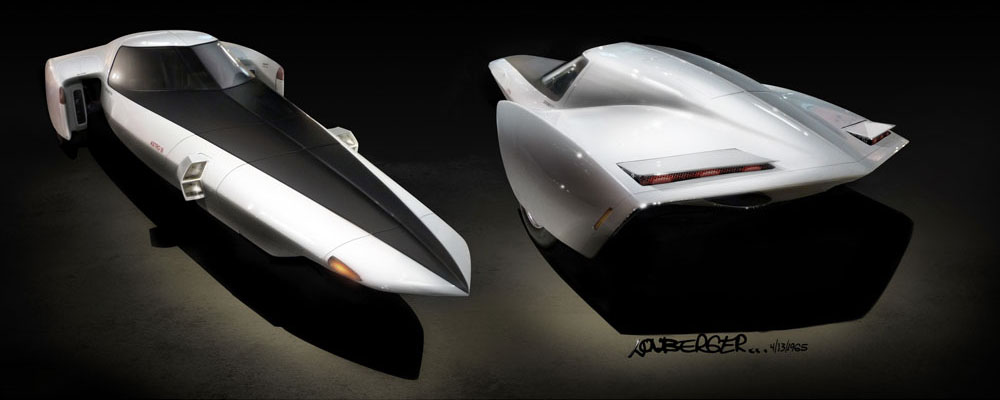
It was 1969, and the first humans on the moon were (and still are) Americans. Jets were replacing prop-driven commercial aircraft. Transistors were replacing tubes in electronics. Computers were about to become personal. We ushered in the high-tech space age. And this car reflects those ideals.
Never meant for the production line, but rather to foreshadow possible foreshadowed alternative power-trains and advanced automotive technology. It had closed-circuit TV rear-view mirrors and drive-by-wire steering. But, it was the engine that really stood out – a gas turbine that weighed just 139 pounds but cranked out 317 hp.
1973 AEROVETTE

That’s not just any Corvette …. it’s a ROTARY-engined Corvette … with a four-rotor Wankel engine producing 420 hp. There was really only one reason John DeLorean, authorized this concept car …. his EGO. He wanted to prove that America could also make a decent rotary engine. The car was actually well received. But, tooling and changeover costs put production on ice.
2003 CADILLAC SIXTEEN
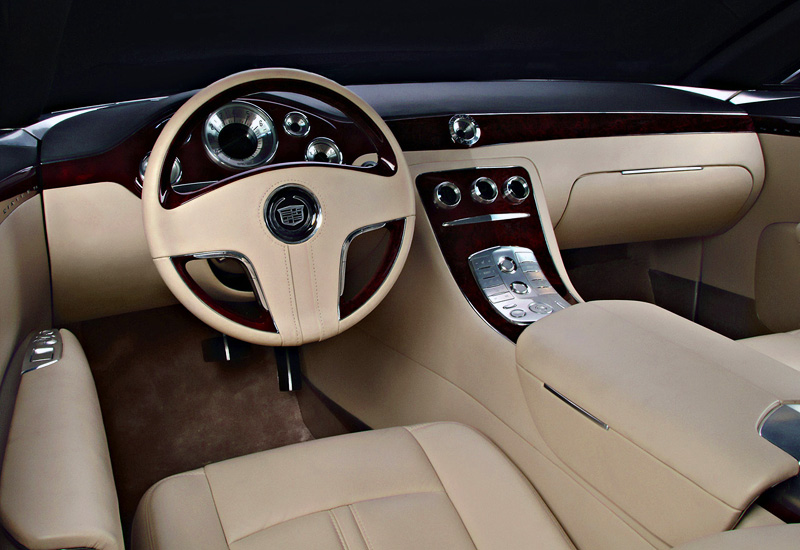
Designed to restore the sagging prestige of Cadillac, like a phoenix rising from the ashes. Supposedly, the Sixteen just narrowly missed production approval. Subsequent generation of Cadillac products, particularly the revised CTS, have incorporated several elements of the Sixteen’s design.
Features: 24-inch tires, a super-luxurious cabin for four, an all-glass roof, invisible B-pillars, and extensive use of real crystal for both interior and exterior decor. Under the hood; a V-16 engine displacing 13.6 liters and producing an incredible 1000 horsepower and 1000 lb-ft of torque. 0-60 in 4 seconds, top speed 160mph. Price? Don’t ask.
2015 FEMA PEOPLE CARRIER, Model S.H.T.F.

By 2016 scientists will have figured how how to mechanically harness all the lies and bullshit produced by the USA!USA!USA! Congress. As such, the 535 cubic inch engine is expected to produce virtually unlimited power … some say as much as 317 million horsepower. By 2020, the Obongo Oreo Special will be just one cubic inch, and three times as powerful. Each POM (Pods Of Malcontents) will seat 100 citizens … all designed with your safety and liberty in mind. The POMs are modular, and as many as necessary can be added to the vehicle (even enough to evacuate all of NYC). Most of you will be passengers in this vehicle, sooner than you think.
2020 FORD 30-BOS AV

Our own Administrator, here on The Burning Platform ( www.theburningplatform.com ), if he wants to stay alive on his way to and from work through The City of Brotherly Love, will be driving the 2020 Ford 30-BlocksOfSqualor (BOS) Assault Vehicle.



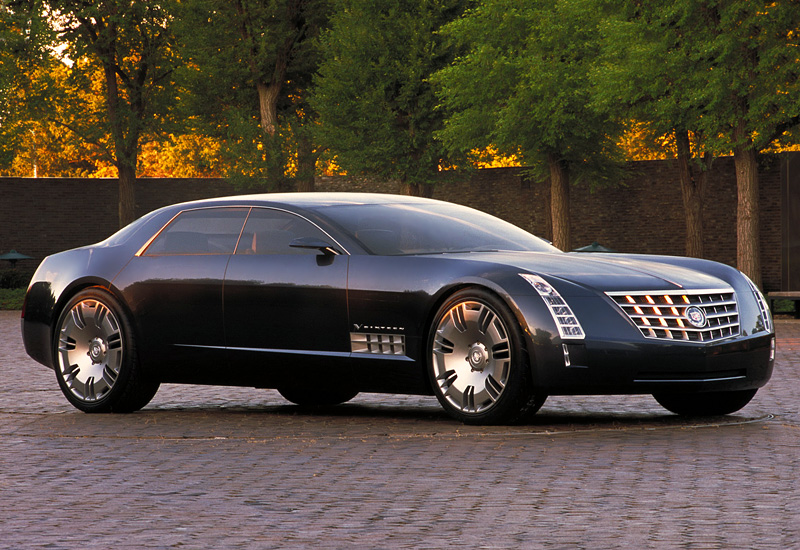

Great article, thanks. BTW, the story on the LeSabre…the name was intended, as stated, to invoke the Sabre jet, and the logo was supposed to look like an upside-down Mercedes badge, to poke fun at our erstwhile adversaries.
Yesterday my sister took my mother to NYC to get “pre-screened” for her January 31st hip replacement. I was finally able to get hold of my sister this afternoon to get the results. She failed, pending further inquiry and/or psychological counseling. They asked her if she ever considers suicide. She said “all the time”. So, I have that fucken thought to deal with. I will be offline for a few days as I try to deal with my mother, and my father who is freaking out, and so forth. Peace.
Very interesting series of beautiful photos, Stuck. The photo of the 1963 Chrysler Turbine car brings back a childhood memories- a classmate of mine was the daughter of a popular and wealthy local radio anchor, and at a party for us kids at her house, her dad talked about the new turbine cars Chrysler was supposed to be building, and said that he intended to buy one as soon as they became available… which they never did.
Too bad some of these were never fully realized, especially the Cadillac 16. What a beautiful car- but is there really any market, even among Arab oil sheiks and software billionaires, for a 16-cylander, 830 cu. in. mill that produces 1,000 hp ?
Dear Friends
Please help us blow The Final Trumpet of God, the Words of The Living God spoken to this Generation – The Time is running out…
http://www.trumpetcallofgodonline.com
Blessings and HalleluYah
Excellent, however, no mention of the Dagmars on the ’59 Cyclone, your clutch is slipping.
Sincerely and from the heart Stucky, your car series was one of the most enjoyable things I have experienced on the internet. Thank you so much for your hard work.
Bea
Stucky, I’m very, very sorry to hear about your mom’s distress. This is so sad, I hardly know what to say.
2015 FEMA truck won’t be a Man truck brand. It’ll be a KW or some other American brand.
Every one of these cars looks stupid……
Can’t wait for the fema carrier…Mooooo.
Stuck, Congratz on your article being picked up by LR . +100
Another great article Stucky! I still need to finish following and reading the web links though.
Reading about the exhaust temps of those Firebirds brought to mind a factoid about the fastest air breathing airplane ever made…..exotic even by today’s standards…..the SR-71 Blackbird. Flying at mach or supersonic speeds largely depends on the temperature of what the plane is flying through. The highest claimed speed for an SR-71 is “in excess of” Mach 3.5 which would translate to 2,664 mph at sea level but the true maximum speed was probably quite a bit higher, perhaps in the realm of 3,000mph. The primary limiting factor was the maximum Compressor Inlet Temperature (CIT) listed in the SR-71 operational limits. The inlet temps were limited to 426 Celsius (799 F) to prevent damage to the engine. The static air temp at the altitude the plane flew could be -100F but the friction of air moving into the compressor caused the it to heat up so flying the plane at maximum performance meant managing the CIT temps rather than watching a speed indicator.
Given the intense political ramifications of losing an SR-71 on an operational mission, I’d bet Pratt & Whitney built in a healthy margin of error for safety. Plus, the maximum speed is still classified which is impressive for 1960’s era technology.
Can you imagine if our parents had cars with exhaust temps or 1200F? There is a whole list of stuff I’d like to fry at those temps even today as an adult! I’d have probably gotten my ass run over sitting behind it cooking things!
My buddy said the thing leaked like a sieve and only after the skin heated up in flight it stop leaking fuel. There are a couple on display in Palmdale, you can see them from overhead at Avenue P southwest of Plant 42.
The leaks were exaggerated. The plane did leak but leaks were monitored and quantified against a set of specs. Once leaks exceeded a certain rate at specific joints, the tanks were re-sealed. Besides the imperfect fit of the skin panels at normal ground air temps, the plane also leaked because the tanks were pressurized with inert nitrogen to prevent explosions when the fuel gets heated to over 300F in flight. The nitrogen also prevented the tanks from imploding due to negative pressure during decent.
The last two were the best!